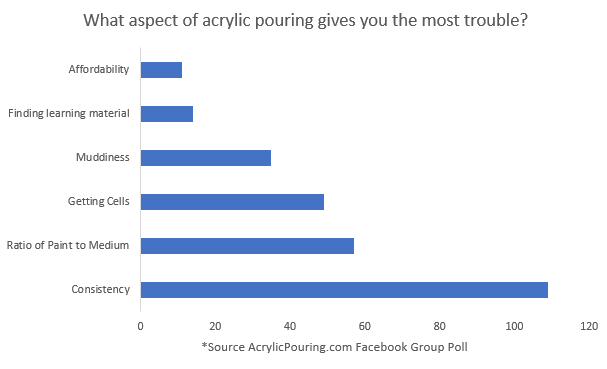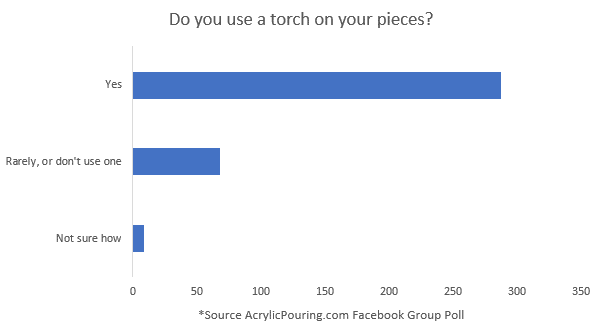I like cold hard facts, tangible evidence, complete data; all the things that an abstract artist isn’t supposed to like. If you’re a part of our fantastic Facebook Group (which you should be if you’re not), you might have seen that we’ve been posting polls recently, asking for your opinions on different techniques, products, etc.
Now, we have over 95k people in the group currently, and to be frank, participation in these polls wasn’t fabulous–I think the most respondents in one poll was 364. If you see us post polls in the future, please, participate! Your opinion matters more than you think.
I really wanted to find out how different we really are as a group. The results were surprising and although the respondent pool is small, we’re still able to get a picture of who we are as an artistic group–and we aren’t really so different!
Curing Time
The Question: How long do you let your pieces cure for?
Number of Respondents: 266

This has always been a divisive topic in our group… and when I say divisive, I mean aggressively so at times. When it comes down to it, only you can make the decision about when to seal your pieces–all we can do is try to give you the best advice possible. If you choose to go a different route, and it works, great! If not, trial and error are an artist’s best friend.
The majority of respondents (103 of you), said that you allow your pieces to cure for 3-4 weeks before sealing. 84 of you said that you always wait at least one full month. Only eight respondents said that they wait over a month for a piece to cure.
50 respondents answered that they wait three days to a week, while 21 respondents said they wait one to two weeks. This was surprising to me, I expected that the one to two weeks timeframe would be the next most popular!
Troubleshooting
The Question: What aspect of acrylic pouring gives you the most trouble?
Number of Responses: 301
You may notice that here, I’ve counted the number of responses as opposed to the number of respondents and while I’d like to say that was intentional, it was due to a little error on my part where I forgot to unselect the option for respondents to pick more than one option. That means, there are more responses than respondents, but I still think this helps us all understand what learning materials are needed.
Consistency remains the top concern among the participants, with 109 respondents saying that this is what they struggle with the most. Consistency really can be quite difficult to master, but we do have plenty of great resources on our blog, and you can always ask the group, too!
The second biggest issue that respondents had was the ratio of paint to medium (57 people). A close third, 49 of you struggle with getting cells (very common, you’re in good company). Muddiness plagues 35 of you, and rounding out the responses were those who struggle with finding concise learning materials or are financially unable to begin.
If you’re struggling with any of these issues, it’s likely that we have a resource to help you learn more so that these frustrations can be a thing of the past. The AcrylicPouring.com blog is an absolute wealth of information, and with this information, we’ll be able to add even more great resources to help you learn.
Cells
The Question: Speaking generally, do you like the look of cells?
Number of Respondents: 60

This is something that wesee pop up in the group from time to time–some artists ask how they can avoid cells because they don’t like the way that they look, while others will try every technique they can to get cells in every piece.
The majority of you said that in certain pieces, you like to see cells (43 respondents). 12 of you said that you’d like to see cells in everything, while just five of you said that you don’t like cells.
This seems to be a pretty good view of how the group thinks–while creating this article, I’ve gone back through our group and looked at the number of posts requesting help with cells versus the number of posts from artists who don’t want cells, and it’s very clear that the desire for cells abounds!
If you’re struggling with coaxing cells out of your pieces, we have a few great resources for cells on our blog.
Art vs Craft
The Question: In your opinion, is acrylic pouring an art or a craft?
Number of Respondents: 273
Now this is a hot topic in the group. Art? Craft? Everyone has an opinion, and sometimes a very strong one.
Out of 273 respondents, 228 of you feel that acrylic pouring is an art. 36 of you believe that the art status of a piece depends on the intention behind it, while just nine of the respondents believed that acrylic pouring is a craft.
Remember, art is defined as something that is created to portray beauty and evoke emotions. If that’s how you’re creating your piece, then it’s art!
Use of Torch
The Question: Do you use a torch on your pieces?
Number of Respondents: 364

When I first posted this question, there were some members suggesting that heat guns be included, but I really wanted to see how many of our artists are specifically applying the heat from a flame to their pieces. We have so many questions in the group about the safety of using a flame, and how it will affect the longevity of the piece.
287 respondents said that they do use a torch, while 68 respondents either don’t use a torch at all or use it rarely. Nine respondents answered that they’d like to use a torch, but aren’t sure how.
If you’re in the group of “unsure how to use a torch” respondents, make sure to use the search function in the Acrylic Pouring Facebook Group to search for “torch”. You’ll find so many great posts with helpful answers from other members about the benefits and drawbacks of using a torch, as well as recommendations for what torch to use.
Sales
The Question: Do you sell your pieces?
Number of Respondents: 55
Some of us began our acrylic pouring journey with absolutely no intention of selling our work, and then slid down the slippery slope into sales! Out of 55 respondents, the split was relatively close. 29 respondents answered that they do sell, while 22 responded that they don’t yet, and four answered that they never would.
Piece Personality
The Question: Do you sign your pieces?
Number of Respondents: 41
The question of not only whether to sign but where to sign pieces is a frequent topic of conversation in our group!
In total, 37 of you answered that you do sign your piece, with 21 signing the back, and 16 signing the front. Four of you answered that you do not sign your pieces at all.
Remember, if you’re unsure about signing your pieces, you can always sign on the back so that the signature doesn’t affect your customer’s ability to turn the painting whichever way feels best to them.
The Question: Do you name your pieces?
Number of Respondents: 84
This is another interesting question that comes up from time to time: should you name your piece? Does the name define the piece if you do?
The majority of respondents (41) answered that they do not name their pieces, with “sometimes” coming in at a close second with 32 respondents. 10 respondents answered that they always name their pieces, while one of you responded that you number your pieces instead.
No matter whether you share the name or number with your customers, you can always use a numbering system to catalogue your work so you can look back at what you’ve created, and what’s been successful.
Pouring Longevity
The Question: How long have you been pouring?
Number of Respondents: 250
To many people, acrylic pouring seems like a viral trend that will only be a flash in the pan, but I didn’t think that was truly the case. I’ve been pouring for about three and a half years now, and I know artists that have been pouring for much longer than that. As with everything, pouring might not be someone’s cup of tea or may be something they’d like to try for one piece–and that’s okay, too.
The majority of you (81) answered that you’ve been pouring for at least two years! 70 of you have been pouring for about six months to a year, and 48 of you have been pouring for over two years. 42 of the respondents have been pouring for less than six months, and nine haven’t started yet.
What this says to me is, there are a lot of experienced artists in the group. We are fortunate to welcome artists of all levels into your group, which gives beginning artists the unique and valuable opportunity to learn from their peers.
Final Thoughts
The Acrylic Pouring Facebook Group is a truly amazing place. From my own experience, scrolling through my Facebook feed has been made more colorful and exciting since I get to see your artwork each and every day!
As a fledgling fluid artist and experienced bold line/flash art artist, I had very little confidence in my work. I know that the Acrylic Pouring Facebook Group is the driving force behind my success in fluid art, and my love for it. I hope that you’ll join us so you can be inspired too! And, if you’re already a part of our group, thank you for making it such a special place.

Sara Wagner is an author and artist from Upstate New York. She is the owner of Studio Blackwater and can typically be found covered in paint, cats, or her two young daughters. You can find her on Facebook and Instagram as @studioblackwater.

Love the poll results, next time I will make sure I participate!